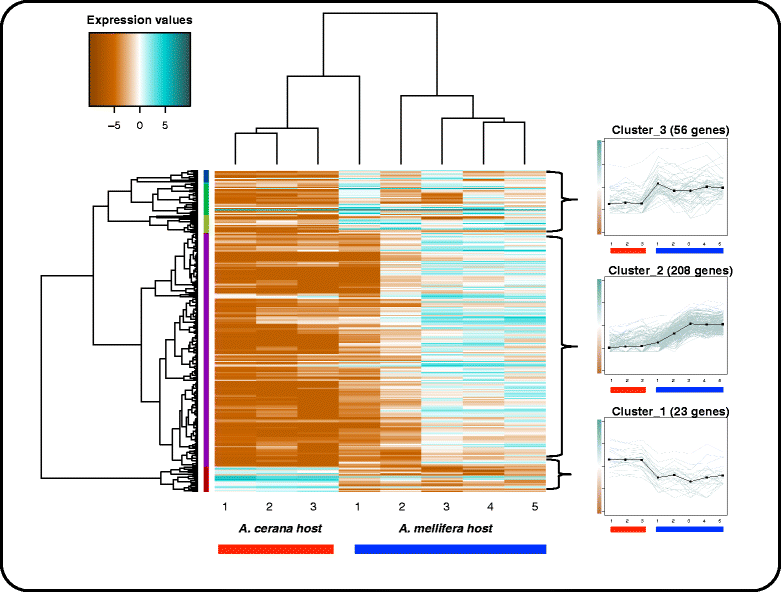Differential gene expression in Varroa jacobsoni mites following a host shift to European honey bees (Apis mellifera)
- PMID: 27852222
- PMCID: PMC5112721
- DOI: 10.1186/s12864-016-3130-3
Differential gene expression in Varroa jacobsoni mites following a host shift to European honey bees (Apis mellifera)
Abstract
Background: Varroa mites are widely considered the biggest honey bee health problem worldwide. Until recently, Varroa jacobsoni has been found to live and reproduce only in Asian honey bee (Apis cerana) colonies, while V. destructor successfully reproduces in both A. cerana and A. mellifera colonies. However, we have identified an island population of V. jacobsoni that is highly destructive to A. mellifera, the primary species used for pollination and honey production. The ability of these populations of mites to cross the host species boundary potentially represents an enormous threat to apiculture, and is presumably due to genetic variation that exists among populations of V. jacobsoni that influences gene expression and reproductive status. In this work, we investigate differences in gene expression between populations of V. jacobsoni reproducing on A. cerana and those either reproducing or not capable of reproducing on A. mellifera, in order to gain insight into differences that allow V. jacobsoni to overcome its normal species tropism.
Results: We sequenced and assembled a de novo transcriptome of V. jacobsoni. We also performed a differential gene expression analysis contrasting biological replicates of V. jacobsoni populations that differ in their ability to reproduce on A. mellifera. Using the edgeR, EBSeq and DESeq R packages for differential gene expression analysis, we found 287 differentially expressed genes (FDR ≤ 0.05), of which 91% were up regulated in mites reproducing on A. mellifera. In addition, mites found reproducing on A. mellifera showed substantially more variation in expression among replicates. We searched for orthologous genes in public databases and were able to associate 100 of these 287 differentially expressed genes with a functional description.
Conclusions: There is differential gene expression between the two mite groups, with more variation in gene expression among mites that were able to reproduce on A. mellifera. A small set of genes showed reduced expression in mites on the A. mellifera host, including putative transcription factors and digestive tract developmental genes. The vast majority of differentially expressed genes were up-regulated in this host. This gene set showed enrichment for genes associated with mitochondrial respiratory function and apoptosis, suggesting that mites on this host may be experiencing higher stress, and may be less optimally adapted to parasitize it. Some genes involved in reproduction and oogenesis were also overexpressed, which should be further studied in regards to this host shift.
Keywords: Apis cerana; Apis mellifera; Asian honey bee; European honey bee; RNA-Seq; Transcriptome; Varroa destructor; Varroa jacobsoni.
Figures


Similar articles
-
Multiple host shifts by the emerging honeybee parasite, Varroa jacobsoni.Mol Ecol. 2015 May;24(10):2379-91. doi: 10.1111/mec.13185. Epub 2015 Apr 22. Mol Ecol. 2015. PMID: 25846956
-
Tolerance of Honey Bees to Varroa Mite in the Absence of Deformed Wing Virus.Viruses. 2020 May 23;12(5):575. doi: 10.3390/v12050575. Viruses. 2020. PMID: 32456246 Free PMC article.
-
Varroa jacobsoni (Acari: Varroidae) is more than one species.Exp Appl Acarol. 2000 Mar;24(3):165-89. doi: 10.1023/a:1006456720416. Exp Appl Acarol. 2000. PMID: 11108385
-
Understanding the Enemy: A Review of the Genetics, Behavior and Chemical Ecology of Varroa destructor, the Parasitic Mite of Apis mellifera.J Insect Sci. 2022 Jan 1;22(1):18. doi: 10.1093/jisesa/ieab101. J Insect Sci. 2022. PMID: 35137134 Free PMC article. Review.
-
Varroa destructor: A Complex Parasite, Crippling Honey Bees Worldwide.Trends Parasitol. 2020 Jul;36(7):592-606. doi: 10.1016/j.pt.2020.04.004. Epub 2020 May 23. Trends Parasitol. 2020. PMID: 32456963 Review.
Cited by
-
Transcriptomic and Physiological Analysis Reveals the Responses to Auxin and Abscisic Acid Accumulation During Vaccinium corymbosum Flower Bud and Fruit Development.Front Plant Sci. 2022 Feb 15;13:818233. doi: 10.3389/fpls.2022.818233. eCollection 2022. Front Plant Sci. 2022. PMID: 35242154 Free PMC article.
-
MdMYB8 is associated with flavonol biosynthesis via the activation of the MdFLS promoter in the fruits of Malus crabapple.Hortic Res. 2020 Feb 1;7:19. doi: 10.1038/s41438-020-0238-z. eCollection 2020. Hortic Res. 2020. PMID: 32025322 Free PMC article.
-
Identification of Key Gene Networks Associated With Cell Wall Components Leading to Flesh Firmness in Watermelon.Front Plant Sci. 2021 Jun 22;12:630243. doi: 10.3389/fpls.2021.630243. eCollection 2021. Front Plant Sci. 2021. PMID: 34239519 Free PMC article.
-
Identification of key gene networks controlling organic acid and sugar metabolism during watermelon fruit development by integrating metabolic phenotypes and gene expression profiles.Hortic Res. 2020 Dec 1;7(1):193. doi: 10.1038/s41438-020-00416-8. Hortic Res. 2020. PMID: 33328462 Free PMC article.
-
Identification of new regulators through transcriptome analysis that regulate anthocyanin biosynthesis in apple leaves at low temperatures.PLoS One. 2019 Jan 29;14(1):e0210672. doi: 10.1371/journal.pone.0210672. eCollection 2019. PLoS One. 2019. PMID: 30695036 Free PMC article.
References
Publication types
MeSH terms
Substances
LinkOut - more resources
Full Text Sources
Other Literature Sources

